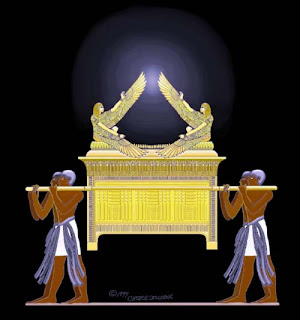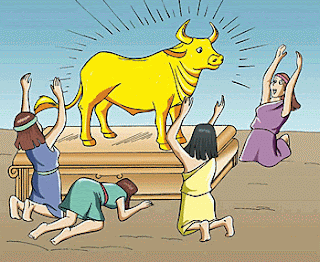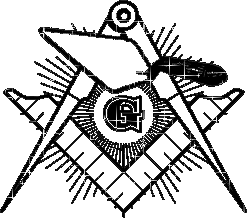Apron. There is no one of the symbols of Speculative Masonry more important in its teachings, or more interesting in its history, than the lambskin or white leather apron. Commencing the lessons at an early period in the Mason's progress, it is impressed upon his memory as the first gift which he receives, the first symbol which is explained to him, and the first tangible evidence which he posses of his admission into the Fraternity. Whatever may be his future advancement in the "royal art," into whatsoever deeper arcana his devotion to the mystic Institution or his thirst for knowledge may subsequently lead him, with the lambskin apron - his first investiture - he never parts. Changing perhaps its form, and its decorations, and conveying, at each step, some new but still beautiful allusion, its substance is still there, and it continues to claim the honored title by which it was first made known to him, on the night of his initiation, as "
the badge of a Mason."
If in less important parts of our ritual there are abundant allusions to the manners and customs of the ancient world, it is not to be supposed that the Masonic rite of investiture - the ceremony of clothing the newly-initiated candidate with this distinctive badge of his profession - is without its archetype in the times and practices long passed away. It would, indeed, be strange, while all else in Masonry is covered with veil of antiquity, that the apron alone, its most significant symbol, should be indebted for its existence to the invention of a modern mind.
On the contrary, we shall find the most satisfactory evidence that the use of the apron, or some equivalent mode of investiture,
as a mystic symbol, was common to all the nations of the earth from the earliest periods.
Among the Israelites the girdle formed a part of the investiture of the priesthood. In the mysteries of Mithras, in Persia, the candidate was invested with a white apron. In the initiations practiced in
HindoSTAN, the ceremony of investiture was preserved, but a sash, called the sacred
zennar, was substituted for the apron. The Jewish sect of the
Essenes clothed their novices with a white robe. The celebrated traveler Kaempfer informs us that the Japanese, who practiced certain rites of initiation, invest their candidates with a white apron,
bound round the loins with a zone or girdle. In the Scandinavian rites, the military genius of the people caused them to substitute a white shield, bit its presentation was accompanied by an emblematic instruction not unlike that which is connected with the Mason's apron.
"The apron," says Dr. Oliver, (S. and S., Lect. X., p. 196,) "appears to have been in ancient times an honorary badge of distinction. In the Jewish economy none but the superior orders of the priesthood were permitted to adorn themselves with ornamented girdles, which were made of blue, purple, and crimson, decorated with gold, upon a ground of fine whit linen, while the inferior priests wore only plain white.
The Indian, the Persian, the Jewish, the Ethiopian, and the Egyptian aprons, though equally superb, all bore a character distinct from each other. Some were plain white ones, others striped with blue, purple, and crimson; some were of wrought gold, others adorned and decorated with superb tassels with fringes. In a word, though the principal honor of the apron may consist in innocence of conduct and purity of heart, (brainwashed candidates) yet it certainly appears through all ages to have been a most exalted badge of distinction. In primitive times it was rather an ecclesiastical than a civil decoration; although in some cases the apron was elevated to great superiority as a national trophy.
The royal standard of Persia was originally an apron in form and dimensions. At this day it is connected with ecclesiastical honors; for the chief dignitaries of the Christian church, wherever a legitimate establishment, with the necessary degrees of rank and subordination is formed, are invested with aprons as peculiar badge of distinction,
which is a collateral proof of the fact that Masonry was originally incorporated with the various systems of divine worship used by every people in the ancient world. Masonry retains the symbol or shadow; it cannot have renounced the reality or substance.
In the Masonic apron two things are essential to the due preservation of its symbolic character - its color and its material.
1.
As to its color. The color of a Mason's apron should be pure unspotted white. This color has in all ages and countries, been esteemed an emblem of innocence and purity. It was with this reference that a portion of the vestments of the Jewish priesthood was directed to be white. In the Ancient Mysteries the candidate was always clothed in white. "The priest of the Romans," says Festus, "were accustomed to were white garments when they
sacrificed." In the Scandinavian rites it has been seen that the shield presented to the candidate was white. The Druids changed the color of the garment presented to their initiates with each degree; white, however, was the color appropriated to the last, or degree of perfection. And it was, according to their ritual, intended to teach the aspirant that none were admitted to that honor but such as were cleansed from all impurities both of body and mind. In the early ages of the Chri
stian c
hurch a white garment was always placed upon the catechumen who had been newly baptized, to denote that he had been cleansed from his former sins, and was thenceforth to lead a life of purity. Hence it was presented to him with this solemn charge: "Receive the white and undefiled garment, and produce it unspotted before the tribunal of our Lord Jesus Christ,
that you may obtain eternal life(genetic engineering)." From all these instances we learn that white apparel was anciently used as an emblem of purity, and for this reason the color has been preserved in the apron of the Freemason.
2.
As to its material. A Mason's apron
must be made of lambskin. (Sacrifice) No other substance, such as linen, silk, or satin, could be substituted , without entirely destroying the emblematic character of the apron, for the material of the mason's apron constitutes one of the most important symbols of his profession. The lamb has always been considered as a symbol of innocence. And hence we are taught, in the ritual of the first degree, that, "by the lambskin, the Mason is reminded of that purity of life and rectitude of conduct which is so essentially necessary to his gaining admission into the Celestial Lodge above, where the Supreme Architect of the Universe forever presides."
The true apron of a Mason must be unspotted lambskin, from 14 to 16 inches wide, from 12 to 14 deep, with a fall about 3 or 4 inches deep, square at the bottom, and without device or ornament of any kind. The usage of the Craft in this country has, for a few years past, allowed a narrow edging of blue ribbon in the symbolic degrees. to denote the universal friendship which constitutes the bond of the society, and of which virtue blue is the Masonic emblem. But this undoubtedly is an innovation, for the ancient apron was without any edging or ornament. In the Royal Arch degree the lambskin is, of course, continued to be used, but according to th esame modern custom, there is an edging of red, to denote the zeal and fervency which should distinguish the possessors of that degree. All extraneous ornaments and evices are in bad taste, and detract from the symbolic character of the investiture. But the silk or satin aprons, bespangled and painted and embroidered, which have been gradually creeping into our Lodges, have no sort of connection with Ancient Craft Masonry. They are an innovation of our French brethren, who are never pleased with simplicity, and have by their love of tinsel in their various newly-invented ceremonies, effaced many of the most beautiful and impressive symbols of our Institution. A Mason who understands and appreciates the true symbolic meaning of his apron, would no more tolerate a painted or embroidered satin one than an artist would a guilded statue. By him, the lambskin and the lambskin alone, would be considered as the badge "
more ancient than the Golden Fleece, or Roman Eagle, and more honorable than the Star and Garter."
The Grand Lodge of England is precise in its regulations for the decorations of the apron, which are thus laid down in its Constitution.
"
Entered Apprentices. - A plain white robe lambskin, from fourteen to sixteen inches wide, twelve to fourteen inches deep,
square at bottom and without ornament; white strings.
"
Fellow Craft. - A plain white lambskin, similar to that of the Entered Apprentice, with the addition only of two sky-blue rosettes at the bottom.
"
Master Masons. - The same, with sky-blue lining and edging, one and half inch deep, and an additional rosette on the fall or flap, and silver tassels. No other color or ornament shall be allowed, except to officers and past officers of Lodges who may have the emblem of their offices in silver or white in the center of the apron; and except as to the members of the Prince of Wales' Lodge, No. 324, who are allowed to wear a narrow internal border of garter-blue in their aprons.
"
Grand Stewards, present and past. - Aprons of the same dimensions lined with crimson, edging of the same color three and a half inches, and silver tassels. Provincial Grand Stewards, while in office, the same, except that the edging is only two inches wide. The collars of the Grand Stewart's Lodge to be crimson ribbon, four inches broad.
"
Grand Officers of the United Grand Lodge, present and past. - Aprons of the same dimensions lined with garter-blue, and ornamented with gold and with blue strings: they must have the emblems of their offices in gold or blue in the center with in a double circle, in the margin of which must be inserted the name of the province. The garter-blue edging to the aprons must not exceed two inches in width.
"The apron of the Deputy Grand Master to have the emblem of his office in gold embroidery in the center, and the
pomegranate and lotus alternately embroidered in gold on the edging.
The apron of the Grand Master is ornamented with the blazing sun embroidered in gold in the center; on the edging the pomegranate and lotus with the seven-eared wheat at each corner, and also on the fall; all in gold embroidery; the fringe of gold bullion.
"The apron of the pro Grand Master the same.
"The Masters and Past Masters of Lodges to wear, in lieu and in the places of three rosettes on the Master Mason's apron, perpendicular lines upon horizontal lines, thereby forming three several sets of two right angles; the length of the horizontal lines to be two inches and a half each, and of the perpendicular lines one inch; these emblems to be of ribbon, half an inch broad, and the same color as the lining and edging of the apron. If Grand Officers similar emblems of garter-blue or gold."
In this country although there is evidence in some old aprons, still existing, that rosettes were formerly worn, there are now no distinctive decorations for the aprons of the different symbolic degrees. The only mark of distinction is in the mode of wearing; and this differs in the different jurisdictions, some wearing the Master's apron
turned up at the corner, and others the Fellow Craft. The authority of Cross, in his plate of the Royal Master's degree in the older editions of his Hieroglyphics Chart, conclusively shows that he taught in the former method; although the latter is now the more common usage.
As we advance to the higher degrees, we find the apron varying in its decorations and in the color of its border, which are, however, always symbolical of some idea taught in the degree.
Masonic Encyclopedia

OBSERVE~ANALYZE~CONCLUDE!














